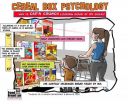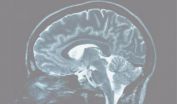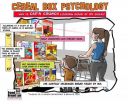(Press-News.org) Infants show unique physiological and behavioral responses to pleasant touch, which may help to cement the bonds between child and parent and promote early social and physiological development, according to research published in Psychological Science, a journal of the Association for Psychological Science.
Previous studies with adults have shown that when the skin is stroked, a specific type of touch receptor is activated in response to a particular stroking velocity, leading to the sensation of "pleasant" touch. Cognitive neuroscientist Merle Fairhurst of the Max Planck Institute for Human Cognitive and Brain Sciences in Leipzig, Germany, and colleagues hypothesized that this type of response might emerge as early as infancy.
For the study, Fairhurst and colleagues had infants sit in their parents' laps while the experimenter stroked the back of the infant's arm with a paintbrush. The experimenter varied the rate of the brushstrokes among three defined velocities (0.3, 3, or 30 cm per second). The experimenters gauged the infants' responses through physiological and behavioral measures.
The results showed that the infants' heart rate slowed in response to the brushstrokes but only when the strokes were of medium velocity; in other words, the touch of the medium-velocity brush helped to decrease their physiological arousal. The infants also showed more engagement with the paintbrush during the medium-velocity brushstrokes, as measured by how long and how often they looked at the brush while they were being stroked.
Interestingly, infants' slower heart rate during medium-velocity brushstrokes was uniquely correlated with the primary caregivers' own self-reported sensitivity to touch. That is, the more sensitive the caregiver was to touch, the more the infant's heart rate slowed in response to medium-velocity touch.
The researchers note that this link between caregiver and infant could be supported by both "nurture" and "nature" explanations:
"One possibility is that infants' sensitivity to pleasant touch stems from direct or vicarious experience of differing levels of social touch as a function of their caregiver's sensitivity to social touch," explains Fairhurst. "Another possibility is that social touch is genetically heritable and therefore correlated between caregivers and infants."
According to the researchers, the findings "support the notion that pleasant touch plays a vital role in human social interactions by demonstrating that the sensitivity to pleasant touch emerges early in human development."
They argue that the ability to perceive and sensitively response to pleasant touch is likely vital early in life because of the fundamental role that touch plays in affiliation, bonding, and synchrony between infants and caregivers.
Fairhurst and colleagues plan on extending these findings by exploring the brain basis of pleasant touch using neuroimaging tools and by investigating the psychological effects that pleasant touch has on infants' social functioning.
INFORMATION:
This research was carried out in the Early Social Development Laboratory at the MPI CBS and supported by the Max Planck Society. L. Löken is supported by a Sir Henry Wellcome Postdoctoral Fellowship.
Co-authors on the paper include Tobias Grossmann of the Max Planck Institute for Human Cognitive and Brain Sciences in Leipzig, Germany and Line Löken of the University of Oxford, UK.
For more information about this study, please contact: Merle T. Fairhurst at merle.fairhurst@sas.ac.uk or Tobias Grossman at grossman@cbs.mpg.de
The article abstract is available online: http://pss.sagepub.com/content/early/2014/03/28/0956797614527114.abstract
The APS journal Psychological Science is the highest ranked empirical journal in psychology. For a copy of the article "Physiological and Behavioral Responses Reveal 9-Month-Old Infants' Sensitivity to Pleasant Touch" and access to other Psychological Science research findings, please contact Anna Mikulak at 202-293-9300 or amikulak@psychologicalscience.org.
Infants are sensitive to pleasant touch
2014-04-02
ELSE PRESS RELEASES FROM THIS DATE:
Key chocolate ingredients could help prevent obesity, diabetes
2014-04-02
Improved thinking. Decreased appetite. Lowered blood pressure. The potential health benefits of dark chocolate keep piling up, and scientists are now homing in on what ingredients in chocolate might help prevent obesity, as well as type-2 diabetes. They found that one particular type of antioxidant in cocoa prevented laboratory mice from gaining excess weight and lowered their blood sugar levels. The report appears in ACS' Journal of Agricultural & Food Chemistry.
Andrew P. Neilson and colleagues explain that cocoa, the basic ingredient of chocolate, is one of the most ...
First peanut genome sequenced
2014-04-02
Athens, Ga. – The International Peanut Genome Initiative—a group of multinational crop geneticists who have been working in tandem for the last several years—has successfully sequenced the peanut's genome.
Scott Jackson, director of the University of Georgia Center for Applied Genetic Technologies in the College of Agricultural and Environmental Sciences, serves as chair of the International Peanut Genome Initiative, or IPGI.
The new peanut genome sequence will be available to researchers and plant breeders across the globe to aid in the breeding of more productive ...
'3D' test could reduce reliance on animals for testing asthma and allergy medications
2014-04-02
To determine whether new medicines are safe and effective for humans, researchers must first test them in animals, which is costly and time-consuming, as well as ethically challenging. In a study published in ACS' journal Molecular Pharmaceutics, scientists report that they've developed a simple, "3D" laboratory method to test asthma and allergy medications that mimics what happens in the body, which could help reduce the need for animal testing.
Amir Ghaemmaghami and colleagues note that respiratory conditions, such as asthma and allergies, are becoming more common. ...
World's oldest weather report could revise Bronze Age chronology
2014-04-02
An inscription on a 3,500-year-old stone block from Egypt may be one of the world's oldest weather reports—and could provide new evidence about the chronology of events in the ancient Middle East.
A new translation of a 40-line inscription on the 6-foot-tall calcite block called the Tempest Stela describes rain, darkness and "the sky being in storm without cessation, louder than the cries of the masses."
Two scholars at the University of Chicago's Oriental Institute believe the unusual weather patterns described on the slab were the result of a massive volcano explosion ...
JCI Online ahead of print table of contents for April 1, 2014
2014-04-02
NOS1 expression predicts melanoma-dependent immune dysfunction
Individuals with cancer often exhibit dysfunctional immune signaling in response to interferon (IFN) stimulation. Furthermore, recent evidence indicates that pSTAT-1 levels, which are indicative of IFN responsiveness, in circulating immune cells are predictive of clinical outcome in melanoma patients. In this issue of the Journal of Clinical Investigation, Qiuzhen Liu and colleagues at Southern Medical University, Guangzhou, China determined that melanoma cells have differing capacity to dampen IFN responses ...
Scientists eager to participate in public discourse on environment
2014-04-02
A survey of more than 500 researchers indicates that scientists have the desire to get more involved in public discussion and policy decisions regarding environmental issues, but have concerns about how their efforts might be perceived.
"Scientists debate whether they have a role in advocacy," says Gerald Singh, a PhD student in the Institute for Resources, Environment and Sustainability at UBC, who conducted the survey with his colleagues. "Some feel they need to remain objective and can't engage. Others feel they have a duty to get involved so that decisions are made ...
Eyes in the cereal aisle -- how Cap'n Crunch's gaze is influencing your purchasing
2014-04-02
Director of Cornell's Food and Brand Lab Brian Wansink and post-doctoral lab researcher Aner Tal, are releasing a new study today published in the Journal of Environment and Behavior that discovered consumers are 16 percent more likely to trust a brand of cereal when the characters on the boxes on the supermarket shelves look them straight in the eye. Not surprisingly, the study also found that the gaze of characters on children's cereal boxes is at a downward, 9.6-degree angle, while characters on adult cereal boxes look almost straight ahead.
Wansink says:
"If you ...
Positive, negative thinkers' brains revealed
2014-04-02
EAST LANSING, Mich. --- The ability to stay positive when times get tough -- and, conversely, of being negative -- may be hardwired in the brain, finds new research led by a Michigan State University psychologist.
The study, which appears in the Journal of Abnormal Psychology, is the first to provide biological evidence validating the idea that there are, in fact, positive and negative people in the world.
"It's the first time we've been able to find a brain marker that really distinguishes negative thinkers from positive thinkers," said Jason Moser, lead investigator ...
Cereal box psychology
2014-04-02
Silly rabbit, Trix are for kids! In a study of 65 cereals in 10 different grocery stores, Cornell researchers found that cereals marketed to kids are placed half as high on supermarket shelves as adult cereals—the average height for children's cereal boxes is 23 inches verses 48 inches for adult cereal. A second key finding from the same study is that the average angle of the gaze of cereal spokes-characters on cereal boxes marketed to kids is downward at a 9.6 degree angle whereas spokes-characters on adult cereal look almost straight ahead.
To examine the influence ...
An easier, safer, and more accurate treatment for pancreatic cancer
2014-04-02
(Lebanon, NH, 4/2/14) — Using CT scans with contrast enhancement, Dartmouth researchers measured treatment response to pancreatic cancer photodynamic therapy (PDT) according to a paper published in Physics in Medicine and Biology.
The research team at Dartmouth set out to reduce the imaging obstacles for PDT, a minimally invasive and nontoxic treatment for cancer. "This study implies that treatment response can be reliably predicted using contrast CT. This would represent a major breakthrough in PDT for pancreas cancer that allows for easier, faster treatment tailored ...




